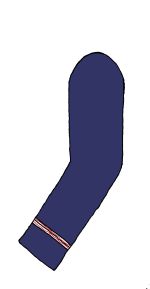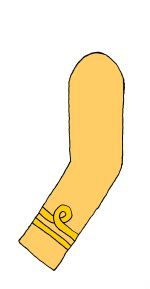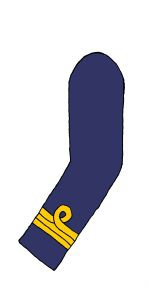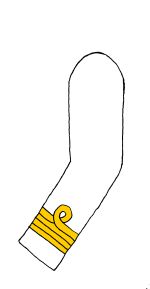Uniforms of the Wissmanntruppe German Officers and NCOs 1889-90
German Officers in the
Wissmanntruppe wore three types of uniforms: a white tropical
service uniform, a blue parade uniform and a khaki field uniform.
Each of these uniforms had a stand and fall collar, six brass
buttons to fasten the front and four brass buttons to fasten the
pockets. The chest pockets were unpleated and sloped slightly
inwards while the hip pockets were straight and unpleated. A
smaller fifth watch pocket was also seen on some uniforms slightly
below the left breast pocket. Several variations of cut may have
been worn on privately tailored uniforms. Officers rank insignia is
described below.German NCOs wore
similar khaki uniforms with rank insignia in the form of yellow metallic
lace chevrons on the left sleeve.
Headgear for all ranks was a white
tropical helmet based on the tall British design of the mid-1880's.
Officers of the Wissmanntruppe are seen wearing peaked field caps in
some period photographs, some are white while others are darker but their colours cannot be made out for
certain from the monochrome photographs.
Figure 1 is
based on a photograph of Kommandant Hermann von Wissmann,
commander of the Wissmanntruppe taken while on an Expedition to
Kilimanjaro. He wears the white tropical uniform as described above. One
contemporary illustration of Wissmann shows his white tunic to have
a sixth pocket on the right side opposite the small fifth pocket.
This may have been an addition by a private tailor or an artist's
error. Wissmann's rank is shown in the form of four (or possibly
only three seen in the previously mentioned contemporary
illustration) gold bars on
his cuffs with a loop at the top. He wears officers' braided
shoulder straps which as described above may have shown his regular
army ranking. His tall tropical helmet has a wide puggaree scarf
around the hatband copied from the British who in turn had learned
it from the Sikhs in India.
Hermann von Wissmann
(1853-1905) originally served as a Leutnant in the 90th
Mecklenburg Infantry Regiment ("Großherzoglich Mecklenburgisches
Füsilier-Regiment Kaiser Wilhelm Nr.90"). After his time in regular service he made two expeditions
to explore Africa. On the first in 1880-82, he crossed Africa from
the Congo to what would later become German East Africa. On the
second expedition in 1883-85, he was employed by Leopold II of
Belgium to further explore the Congo basin. In 1889 he was appointed
by the German Chancellor Bismarck to lead a military expedition to
crush the Abushiri revolt in German East Africa and enforce German
rule across the colony. For this task, von Wissmann formed the Wissmanntruppe (which
would later become the Schutztruppe of German East Africa). The
rebellion was crushed with ruthless efficiency and von Wissmann went on
to become governor of the colony from 1895-96. Wissmann was killed
in a hunting accident after retiring to Germany.
Figure 2 is
based on a photograph of Chef Emil von Zelewski, of
the Wissmanntruppe probably taken in Germany 1889. He wears the
blue parade or home uniform as described above without shoulder
straps. Interestingly his three rank bars are of the early pattern,
in imperial colours and with no loop at the top. It is not
clear from the original photograph if this tunic has the small fifth
pocket on the left side.
Emil von
Zelewski
(1854-91)
originally served as a Premier Leutnant in the 99th Rhineland Infantry
Regiment ("2. Oberrheinisches Infanterie-Regiment Nr.99") before being transferred to the Wissmanntruppe in 1889. He
served with distinction under von Wissmann and in 1891 was appointed to replace von Wissmann as commander of the
Schutztruppe. Later that year he led an expedition against
the rebellious Hehe. Despite having gained a reputation as a
cautious leader he led his troops into a well prepared Hehe ambush
during which he was killed, along with over 350 of his troops and
entourage.
It was the worst single defeat suffered by the Schutztruppe in
Africa.
Figure 3 is
based on a photograph of Leutnant Stenzler, of the
Wissmanntruppe taken while on an
Expedition to
Kilimanjaro. He wears the khaki tropical uniform
and white tropical helmet as described above. His rank is shown in
the form of two gold bars on his cuffs with a loop at the top,
without shoulder straps. His
canvas gaiters are of a type commonly seen in contemporary
illustrations of the Wissmanntruppe and early Schutztruppe in East
Africa, fastening with several small belts and buckles along the
outside edge. Although not shown on the figures illustrated on this
page officers of
the Wissmanntruppe would have worn either brown leather belts or
braided officers' belts (see Belt Buckles Details Page) with an M79
Army revolver when in action.
Figure 4 is based on a
photograph of a Doctor of the Wissmanntruppe. He wears a
khaki Wissmanntruppe officer's tunic with his rank as Doctor ("Arzt")
shown in the form of two yellow metallic lace bars on the cuff. His
officers shoulder straps bear a brass badge in the shape of the
medical Rod of Asclepius (a snake twisted around a staff). He wears the dark blue cap and trousers
of his home uniform. Note the cap's dark blue hatband and red piping
of the medical corps.
Figure 5 is
based on a photograph of a German NCO of the Wissmanntruppe. He wears the khaki tropical uniform as
described above. The small fifth pocket cannot be seen in the
original photograph although it may be behind the ammunition pouch.
He wears plain khaki shoulder straps. Rank is shown in the from of a
single gold chevron worn on the upper left arm. This chevron has
horizontal edges to it although some photographs and contemporary
illustrations show chevrons with vertical edges. From his second button he has
what looks like a watch chain but may more likely be a signalling
whistle. His white tropical helmet is worn with a khaki cover (as was
often worn in action) and a small imperial cockade.
He wears dark blue/grey puttees
(although contemporary illustration show NCOs may also have worn the
same canvas gaiters as the previous figure) with brown leather
boots. His equipment consists of a brown leather belt with a naval
style belt buckle (see Belt Buckles Details Page) holding a single
1871 smaller cavalry ammunition pouch, his bayonet knot ("Troddel")
can be seen next to his left side. It would most likely have been
issued in the imperial colours as worn by NCOs in the navy and later
Schutztruppe rather than the state colours worn by the regular army.
He is armed with a Jägerbüsche 71 rifle and bayonet.
|
Rank
Insignia for Officers of the Wissmanntruppe |
|
 |
 |
 |
 |
Figure A
Deck Offizier |
Figure B
Leutnant |
Figure C
Chef |
Figure D
Kommandant |
Rank insignia for officers of the
Wissmanntruppe was worn in the naval style of bands of braid around
the cuffs. These bands originally came in the from of lace in the
imperial colours but were soon replaced by bands of yellow metallic
lace with a curl (in the style of the British navy) at the top.
Shoulder straps were not initially worn but were later introduced,
at which time they confusingly showed the officer's previous army
rank rather than their current Wissmanntruppe rank.
Figure A shows the rank insignia
worn by a Deck Offizier. One band of lace showed a junior officer (or naval deck officer),
in this case it is shown on a blue home uniform in the early style
with a band of lace in the imperial colours without a curl at the
top. Figure B shows the
rank insignia worn by a Leutnant. Two bands of lace showed a
Leutnant, in this case it is shown in the later style with bands of
yellow metallic lace with a curl at the top. It is noticeable that
in some photographs the bands of lace are separated, while in other
photographs they are shown sewn directly next to each other. This
illustration shows them slightly separated.
Figure C shows the rank insignia
worn by a Chef. Two bands of lace showed a Chef (or senior
officer), in this case it is shown on a blue home uniform in the
later style with bands of yellow metallic lace with a curl at the
top.
Figure D shows the rank
insignia worn by the Kommandant. Four bands of lace were
reserved for the Kommandant (Hermann von Wissmann), in this case it
is shown on a white tropical uniform in the later style of bands of
yellow metallic lace with a curl at the top.
Doctors attached to the Wissmanntruppe
wore two bands of lace or three in the case of senior doctors ("Chefarzt").
Special thanks on this page to Glenn Jewison
for finding the Wissmanntruppe ranking system described in the July
1933 edition of
"Zeitschrift für Heereskunde". |